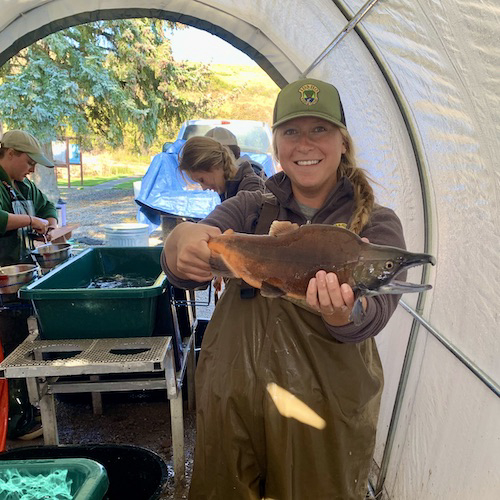
|
This is the first batch of kokanee fingerlings produced by adults that were raised in hatcheries
A million fingerling kokanee are headed to Idaho waters in 2026 thanks to Idaho Fish and Game’s new captive broodstock program aimed at supplementing eggs taken from "wild" fish. It's the first batch produced by Idaho Fish and Game's newest hatchery project aimed at providing stability to the annual number of kokanee fingerlings that can be stocked each spring.
Most kokanee caught by anglers were born in hatcheries, but the eggs that produce them are typically taken from adults that were released as fingerlings and survived in the wild before being recaptured for spawning. The survival rate of those adults is driven by natural conditions, which can fluctuate annually.
Fish and Game aims to stock around 7 million kokanee fingerlings each spring, but a bad year for adult survival can affect how many fingerlings are available in the future because there’s fewer to adults to spawn and produce the next generation. While Fish and Game can't change natural conditions, hatchery production can buffer some of the ups and downs.
“Kokanee fishing is really popular and important to a lot of anglers, so we’re doing our best to meet their expectations,” said Joe Kozfkay, Fish and Game’s state fisheries manager. “We face a lot of uncontrollable natural variables that can make that challenging, but raising broodstock will improve our response to some of that natural variability.”
Starting a broodstock from scratch
The new captive broodstock program didn’t happen overnight. To start it, eggs taken from adult fish in the North Fork Payette River north of McCall were sent to Cabinet Gorge Fish Hatchery in the Panhandle. The eggs were hatched, and the fry reared for a year. Then about 15,000 of them were transferred to the Grace Fish Hatchery in the Southeast Region and reared two more years to spawning age.
In September, the first crop of adult kokanee spawners yielded over 1.6 million eggs, which were then shipped to Mackay Fish Hatchery in the Upper Snake Region, where they will be reared until next spring. With normal attrition of eggs and young fish, Fish and Game expects about a million fingerlings will be available to stock in the spring.
“Wild-origin kokanee and their eggs will still be used to meet most of our kokanee management goals, but the kokanee broodstock project demonstrates it will be a valuable tool to supplement our annual egg supply,” Southeast Fish Hatchery Complex Manager Bryan Grant said.
Fortunately for anglers, this year isn’t a one-and-done study. The next three generations of captive spawners are currently being raised in hatcheries. Given the positive results of the first crop, fisheries managers and hatchery staff are hopeful for greater success in 2026 as hatcheries continue to dial in their captive kokanee spawning techniques.